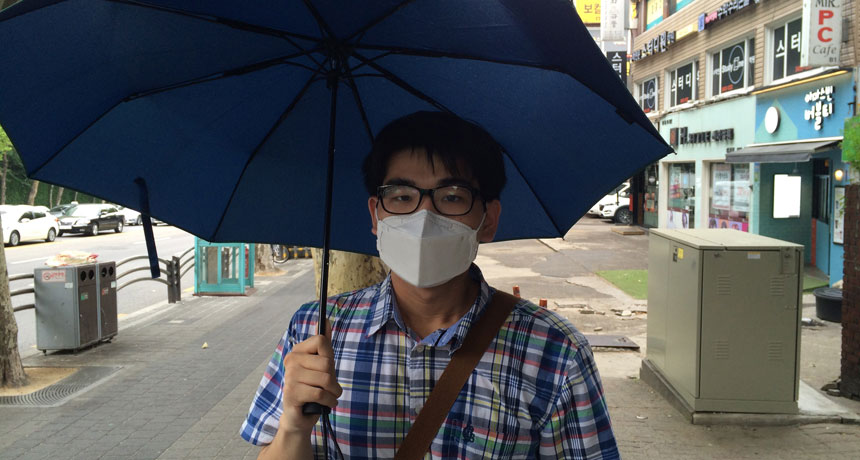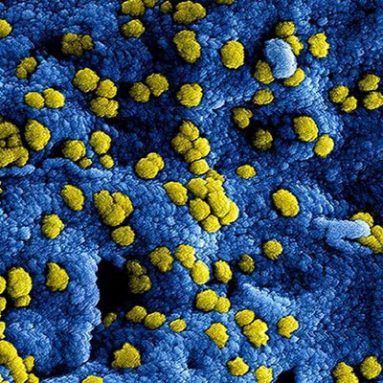MERS virus hits South Korea hard
Many dozens have been sickened and at least six people have died

In South Korea, the MERS virus has sickened dozens and killed six people in recent weeks. Here, teen Tae Wook Kwak wears a surgical mask on his way to school. He hopes it will cut the risk of becoming infected.
Bethany Brookshire/ SSP
South Korea has closed schools and canceled some public events over concerns about a new viral outbreak. Since April, a new disease there has sickened at least 87 people, killing six. All contracted what’s called Middle East respiratory syndrome, or MERS.
The disease can resemble a cold or flu. For instance, its symptoms may include sneezing, diarrhea and vomiting. But in severe cases, people may develop pneumonia or kidney failure.
To date, health officials in South Korea have quarantined more than 2,500 people. All had been in contact with the sick people. A concern was that the large, but limited outbreak could mushroom into a pandemic — a global spread. In fact, the virus seems to spread mostly inside of hospitals or among family members.
The World Health Organization is based in Geneva, Switzerland. Officials there say that standard infection-control measures should end the outbreak. But people in South Korea remain frightened. And that’s with good reason. Since the disease first emerged in 2012, at least 1,179 people have been sickened. Of these, up to four in every 10 have died. In South Korea, now, many people wear surgical masks whenever they go out in public.
When the new infections appeared
As its name suggests, MERS originated in the Middle East. Travelers have carried the virus to other countries before. But unlike in South Korea, there had been very little spread of the infection in those new places. The virus itself has not changed from versions seen in the Middle East. So some sick people may simply shed more of the virus than others do. Scientists refer to such people as “super-spreaders.”

Scientists turned up antibodies — signs of infection — in camels. They also found live MERS virus in bats. So researchers suspect these animals may carry the virus and pass it on to people. In some cases, such animal reservoirs of disease don’t even get sick.
Right now, no one is sure exactly what behaviors allow animals to transmit the virus to people.
Scientists aren’t even sure what risks people face from limited contact with MERS patients.
A South Korean man traveled to the Middle East in April and early May. He got sick shortly after returning home. The virus that causes MERS began to spread in South Korea before doctors realized the returning traveler had the disease.
In the following weeks, another 86 people came down with MERS. These included family members, as well as patients and health care workers in hospitals where the man had been treated. Many of these people had either direct or “indirect” contact with the first patient. Indirect refers to people who never saw the sick man but were in the same hospital ward and somehow caught MERS.
Some people the man infected went on to give MERS to others. For instance, one man who shared a hospital room with the first man later went to a different hospital. There, he spread the virus to 29 others. Another man who caught MERS from the first patient spread it to at least 13 people at yet another hospital.
These third-hand cases worry scientists. In other places, the MERS virus has rarely spread to a third or fourth tier of people. Still, all of the sick people in South Korea (except for the first man) picked up the virus while at a hospital.

But the sick people don’t necessarily stay in the hospital. One person infected by the first patient later flew to Hong Kong. He then took a bus to Guangdong, China. Chinese officials have now isolated that man. They also are looking to identify anyone who might have come in close contact to him during his journey.
Achoo — and then the virus flies
As in South Korea, the MERS virus has spread through hospitals in Saudi Arabia. In fact, this outbreak “feels like Saudi Arabia to me,” says Trish Perl. She’s an infectious disease doctor and epidemiologist, or disease detective, at Johns Hopkins University in Baltimore, Md.
When someone coughs or sneezes, large droplets of germy mucus may spray several feet (a meter or more). Some medical procedures that help patients breathe may turn those droplets carrying the virus into fine mists, called aerosols. This could make it easier for people nearby — or even down the hall — to inhale the germ-ridden mists, Perl says.
“This disease has shown us that it can be very explosive when you don’t take proper precautions,” she says. But isolating patients and using other measures to limit the spread of germs — such as wearing protective garments — can slow or stop outbreaks.
Power Words
(for more about Power Words, click here)
aerosol A tiny particle released in a fine spray or formed when gases or moisture trap tiny bits of solid matter. Some may remain airborne for weeks until they are destroyed, glom onto a surface with which they collide or are washed from the air by rain.
antibodies Any of a large number of Y-shaped proteins that the body produces to fend off infectious invaders such as bacteria and viruses. Antibodies neutralize, tag or destroy viruses, bacteria and other foreign substances in the blood.
epidemic A widespread outbreak of an infectious disease that sickens many people in a community at the same time.
epidemiologist Like health detectives, these researchers figure out what causes a particular illness and how to limit its spread.
germ Any one-celled microorganism, such as a bacterium, fungal species or virus particle. Some germs cause disease. Others can promote the health of higher-order organisms, including birds and mammals. The health effects of most germs, however, remain unknown.
infection The successful invasion of a disease-causing microorganism into the body where it multiples, possibly causing serious injury to tissues (such as the skin, lungs, gut or brain).
inflammation An immune system response to injury or infection. White blood cells flock to the site. The cells gobble microbes and release chemicals to fight the infection. But the chemicals can cause heat, redness, swelling and pain.
kidney Each of a pair of organs in mammals that filters blood and produces urine.
outbreak The sudden emergence of disease in a population of people or animals. The term may also be applied to the sudden emergence of devastating natural phenomena, such as tornadoes.
pandemic An epidemic that affects a large proportion of the population across a country or the world.
pneumonia A lung disease in which infection by a virus or bacterium causes inflammation and tissue damage. Sometimes the lungs fill with fluid or mucus. Symptoms include fever, chills, cough and trouble breathing.
quarantine A temporary restriction on the movement of people (or animals) that are sick — or suspected of being infected — to a small area. The goal is to prevent a spread of their illness. If the illness is life-threatening and an epidemic is underway, police sometimes may be called in to enforce a government-imposed quarantine.
reservoir A large store of something. Lakes are reservoirs that hold water. People who study infections refer to the environment in which germs can survive safely (such as the bodies of birds or pigs) as living reservoirs.
virus A molecule containing genetic information and enclosed in a protein shell. A virus — which can cause illness — can live only in the cells of living creatures. Although scientists frequently refer to viruses as live or dead, in fact no virus is truly alive. It doesn’t eat like animals do, or make its own food the way plants do. It must hijack the cellular machinery of a living cell in order to reproduce.







